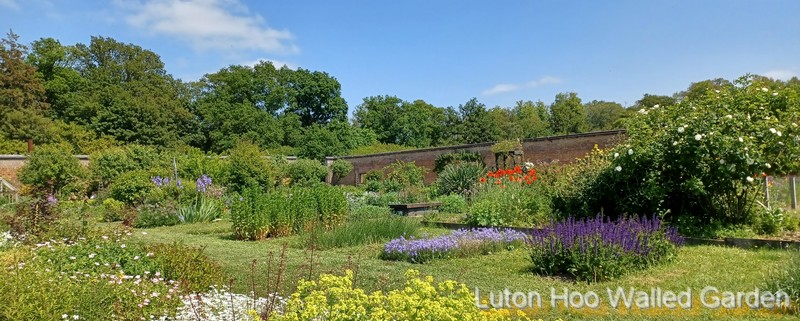A Walled Garden to Impress
It is slightly unusual for me to devote an article to a garden that I have visited but there are two reasons for writing about the Walled Garden at the Luton Hoo Estate. In the interests of transparency I should say that I attended a free Press Day for garden writers that involved lunch and chocolate cake but beyond the prompting to travel a bit further to visit a new garden, there is no bribery and corruption going on! The truth is that I have always loved walled gardens and historic greenhouses and the word Octagonal was enough for me.
 The first remarkable thing is that Luton Hoo has a huge (5 acre) walled garden laid out originally by Capability Brown in the mid 18th Century, believed to be the first octagonal walled garden in the UK. The current glasshouses were built in 1903 with a spectacular octagonal glass fernery (greenhouse for growing ferns) as the centrepiece. Like many country house gardens the production of fruit and vegetables by a large staff of gardeners started to decline with WWII, in fact at Luton Hoo there were still 40 gardeners employed in 1960s, but soon after it fell into disrepair and in particular the glasshouses became unsafe. In addition to the wall and glasshouses there remains an impressive run of service buildings built into the outside of the wall: Head Gardener’s office, potting shed, boiler house, bulb house and a dedicated Vegetable washing room, which nowadays might sound a touch comical but illustrates the scale of production for the house and the family’s London residence in the garden’s heyday.
The first remarkable thing is that Luton Hoo has a huge (5 acre) walled garden laid out originally by Capability Brown in the mid 18th Century, believed to be the first octagonal walled garden in the UK. The current glasshouses were built in 1903 with a spectacular octagonal glass fernery (greenhouse for growing ferns) as the centrepiece. Like many country house gardens the production of fruit and vegetables by a large staff of gardeners started to decline with WWII, in fact at Luton Hoo there were still 40 gardeners employed in 1960s, but soon after it fell into disrepair and in particular the glasshouses became unsafe. In addition to the wall and glasshouses there remains an impressive run of service buildings built into the outside of the wall: Head Gardener’s office, potting shed, boiler house, bulb house and a dedicated Vegetable washing room, which nowadays might sound a touch comical but illustrates the scale of production for the house and the family’s London residence in the garden’s heyday.
Separated from the house (that is now a hotel) in 1994, restoration of the garden started in 2001. And this is where the second impressive fact starts. The outer wall is intact and a great deal of restoration work has been completed so that today there are once again beds of fruit, vegetables and flowers. The long term aim of the glasshouse part of the whole project is not to rebuild and reglaze the houses in their entirety. I can imagine the magnitude and cost of such an ambition plus the question of what that immense range of glass would in reality be used for in 21st C and the ongoing cost of maintenance. Rather the approach is to remove any remaining panes, make safe and repair the wooden structures along with much of the original ironwork for windows, ventilation and staging. So the end result – and several glasshouses have already been completed – is a beautiful weathered version. All that is missing is the glass and that, of course, is transparent anyway, so it is a small leap of the imagination to envisage the original effect.
 When the project kicked off the whole garden and all the glasshouses were filled with rampant weeds, largely brambles with just a few old fruit trees poking out of the top. Why is this impressive? Well, the approach was not to bring in wholesale diggers and skips, instead the restoration of garden, walls and glasshouse frames has and is being done by volunteers who now number over 120. There are teams of volunteers covering every element of the project including researching the history of the garden, greeting and educating visitors (including us), chopping back weeds, taking cuttings of surviving figs and grape vines to replant against the walls and recovering the remaining old fruit trees.
When the project kicked off the whole garden and all the glasshouses were filled with rampant weeds, largely brambles with just a few old fruit trees poking out of the top. Why is this impressive? Well, the approach was not to bring in wholesale diggers and skips, instead the restoration of garden, walls and glasshouse frames has and is being done by volunteers who now number over 120. There are teams of volunteers covering every element of the project including researching the history of the garden, greeting and educating visitors (including us), chopping back weeds, taking cuttings of surviving figs and grape vines to replant against the walls and recovering the remaining old fruit trees.
I spoke to several volunteers from different teams, all happy to explain why they were there and what they gained from giving their time. There were common themes, and many that are common to all sorts of volunteering activities but the sense of achievement and community, contribution, pride and personal commitment to the outcome shone through. Some individuals have been volunteering at Luton Hoo Walled Garden for 15 years, others for 3 years and at a recent recruitment event another 30 people enrolled. The social and community element was strong: maintaining sociability after retirement, avoiding isolation after moving to a new area, developing friendships. Unsurprisingly, and very nice to hear for me, a horticultural therapy advocate, time spent out of doors in the natural world was seen as a benefit to general wellbeing. Several people highlighted using and learning skills, an outlet for a long term interest whether that be woodworking or historical research, as well of course as gardening on an epic scale. Seriously, is there a ‘home gardener’ out there who does not crave a walled garden to call their own? Well this seems to be a very good next best thing because of how the project is organised.
The Luton Hoo volunteer project has been running since 2001 and goes from strength to strength and this is not such a common experience. I expect that there have been hiccups along the way but two fundamentals stood out for me as useful learning for any organisation reliant on volunteering. There is structure: volunteers work in teams with particular focus, of course individuals can change teams to move from gardening to research etc. but there is clearly a plan with well communicated priorities, it is not a “what needs doing today?” free-for-all. And integral to the structure is volunteer empowerment. It was emphasised that all work is volunteer led, meaning that volunteers form committees for each specialism and solicit, research, evaluate and recommend projects. Final decisions rest with the owners of course, but great store is placed on their volunteers’ expertise and experience. One of the conservation team explained to me that this is satisfying because it enables the volunteers to maximise the value of their time and effort to the overall aim of restoring this fabulous garden. A clear demonstration of volunteers being appreciated and empowered is surely the key to success for any project.
We may not all have an octagonal walled garden and glasshouse to work with but there is a lesson too for us all at home. However overgrown your garden gets, it is always possible to restore, update and recreate or reinvent it if you have vision, enthusiasm and, possibly most importantly, a plan. Chocolate cake never goes amiss either.
Happy Gardening from Alison
Luton Hoo Walled Garden is open to visitors on Wednesdays between May and September. Details HERE

